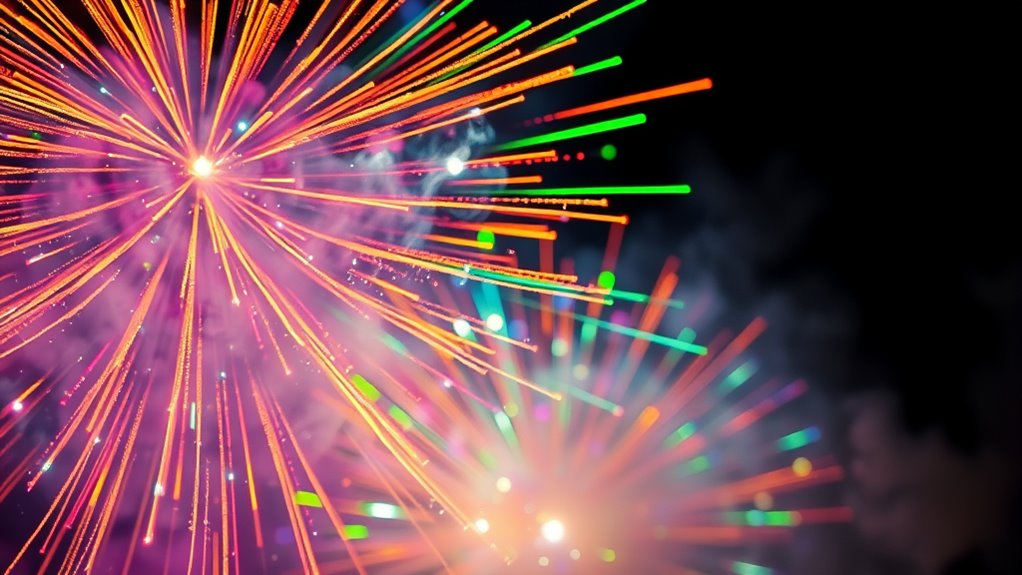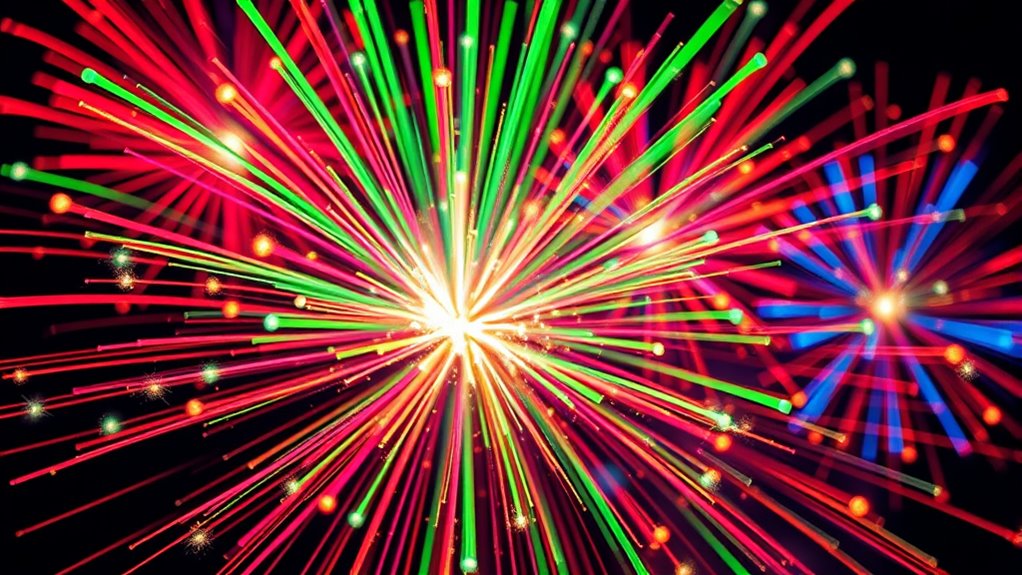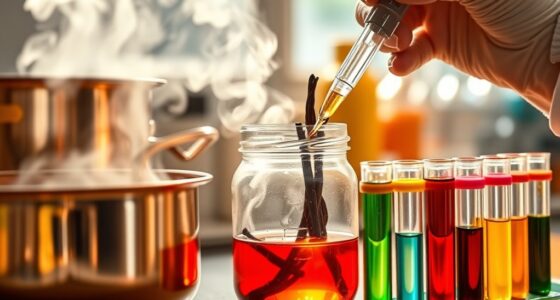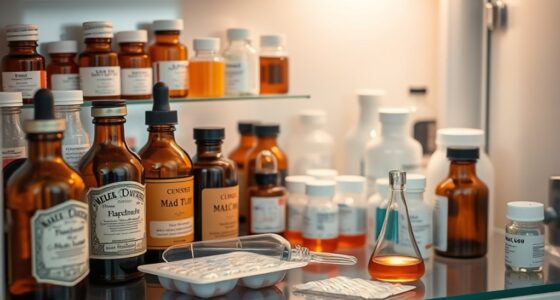Fireworks produce different colors because they contain specific chemicals that emit unique wavelengths of light when heated. When these compounds are excited by heat, their electrons jump to higher energy levels, then release light as they return to normal. For example, copper makes blue and green, while strontium provides bright red. The mix of chemicals, heat, and oxygen creates vibrant displays. Keep exploring to discover how these elements and reactions create the stunning colors you see.
Key Takeaways
- Different elements emit specific wavelengths of light when excited by heat, producing distinct colors.
- Metal salts like copper, strontium, sodium, and calcium create vibrant hues based on their spectral lines.
- The temperature and energy released during combustion influence the excitation of atoms and their emitted colors.
- Chemical compositions, including oxidizers and reducing agents, affect the intensity and variety of colors produced.
- Spectral analysis of emitted light reveals element-specific signatures that determine the fireworks’ colors.
The Science of Light Emission in Fireworks

When a firework explodes, it releases energy that excites the atoms and molecules inside it. This energy causes them to jump to higher energy levels. As they return to normal, they emit light across the visual spectrum, creating the bright colors you see. The specific wavelengths of this emitted light determine the color, which depends on how the atoms or molecules absorb and release light. Light absorption plays a vital role because it filters certain wavelengths, allowing others to pass through and reach your eyes. The spectrum of visible light is broad, and each element produces a unique set of emission wavelengths. This process of light emission and absorption defines the vibrant, dazzling displays in fireworks, mesmerizing your senses with a spectrum of brilliant colors. Additionally, Element-specific emission wavelengths are fundamental to understanding how different colors are produced in fireworks. The chemical composition of the fireworks determines which elements are present and thus which colors will be emitted during the explosion. Moreover, spectral lines are specific to each element and help scientists identify the elements used based on the colors observed.
Elements Responsible for Color Production

Different elements in fireworks are responsible for producing their vibrant colors by emitting specific wavelengths of light when excited. These metal salts are carefully chosen because they produce distinct elemental colors. For example, copper compounds create blue and green hues, while strontium salts generate bright reds. Sodium salts produce intense yellow colors, and calcium salts give off orange shades. When ignited, the heat excites the electrons in these metal salts, causing them to jump to higher energy levels. As they return to their normal state, they release energy in the form of visible light with specific wavelengths. These wavelengths correspond to the different colors you see in fireworks displays. The process of spectral emission is fundamental to understanding how different colors are produced. By selecting the right metal salts, pyrotechnicians craft a dazzling palette of colors for your enjoyment. Research-backed insights into chemical reactions enhance our understanding of how these vibrant displays are created. Additionally, the excitation process involves complex chemical interactions that influence the intensity and hue of the emitted light.
How Heat Changes Elemental Properties

Heat can substantially alter the properties of elements by providing energy that excites their atoms and electrons. When you heat an element, thermal excitation occurs, causing electrons to jump to higher energy levels. This change can be observed through spectral analysis, which detects the light emitted as electrons return to lower states.
Here’s what happens:
- The element’s electrons become energized, changing its emission spectrum.
- The energy absorption shifts the element’s spectral lines, revealing different colors.
- These changes help scientists understand how heat influences atomic behavior and spectral signatures.
Chemical Compounds Used for Vibrant Hues

Have you ever wondered what gives fireworks their dazzling colors? It all comes down to specific chemical compounds that produce vibrant hues through chemical reactions. When heated, these compounds emit lights at characteristic wavelengths, which spectral analysis confirms. For example, copper compounds create blue and green shades, while strontium yields bright red. Understanding these compounds helps pyrotechnicians control the colors in displays. Here’s a quick overview:
| Element | Color Produced |
|---|---|
| Copper | Blue, Green |
| Strontium | Bright Red |
| Barium | Green |
| Sodium | Yellow |
| Lithium | Red |
These compounds’ unique spectral signatures allow precise color control, making fireworks both beautiful and scientifically fascinating. Spectral signatures are crucial in identifying and manipulating the colors produced in pyrotechnic displays. Additionally, the chemical reactions involved are carefully engineered to ensure safety and optimal visual effects during fireworks shows.
The Role of Oxidizers and Reducing Agents

Oxidizers and reducing agents play a crucial role in producing the intense colors and energetic explosions seen in fireworks displays. The oxidizers’ function is to supply oxygen, fueling the combustion process that creates bright, vibrant colors. Without them, the reactive metals and compounds wouldn’t burn properly. Reducing agents, on the other hand, donate electrons, helping to excite metal ions that produce specific hues. Color formation depends heavily on the precise mixture of these chemicals to achieve desired visual effects. Understanding firework chemistry can help explain how different compounds produce those stunning colors. Here’s how they work together:
- Oxidizers provide the oxygen needed for combustion, energizing the chemical reactions.
- Reducing agents supply electrons, which excite metal ions to emit colorful light.
- Their interaction results in the vivid colors and explosive energy you see in the sky.
This balance determines the brilliance and variety of fireworks displays.
Frequently Asked Questions
How Do Environmental Factors Influence Firework Colors?
Environmental factors like atmospheric conditions and chemical reactions influence firework colors. When you watch fireworks, the temperature, humidity, and wind can alter how chemicals react and emit light. For example, higher humidity may dampen colors, while temperature changes can affect chemical reactions’ intensity. These factors can make colors appear more vibrant or dull, impacting your overall viewing experience. So, nature plays a subtle but important role in fireworks’ dazzling displays.
Can Custom Fireworks Be Created to Produce Specific Colors?
You can create custom fireworks to produce specific colors by adjusting their chemical composition. By carefully selecting and combining certain metal salts and chemicals, you can achieve precise color customization. This process involves understanding how different elements emit distinct colors when heated. With the right formulation, you can design fireworks that display exactly the hues you desire, making your displays uniquely vibrant and tailored to your preferences.
Why Do Some Fireworks Change Color Mid-Air?
Fireworks changing color mid-air is like a painter blending colors on a canvas. You see, as the chemical reactions unfold, different metal compounds ignite, emitting light spectra that shift. These color changes happen because the temperature varies, altering the energy levels of electrons. Consequently, the colors you see are a dynamic display of chemical reactions, creating a mesmerizing dance of hues that captivate your eyes and imagination.
Are There Health Risks Associated With Different Fireworks Colors?
You might wonder if different fireworks colors pose health risks. Some fireworks contain toxic chemicals like heavy metals, which can release harmful fumes when ignited. These fumes may cause respiratory irritation or other health issues, especially for those with asthma or sensitivities. To stay safe, enjoy fireworks in well-ventilated areas and avoid inhaling smoke. Always follow safety guidelines to minimize exposure to potential toxic chemicals.
How Do Cultural Preferences Affect the Colors Used in Fireworks Displays?
Colorful cues captivate your senses, and cultural preferences profoundly influence fireworks displays. You’ll notice that cultural symbolism and regional traditions dictate color choices—like red for luck in China or green for Islam. These preferences shape your spectacular shows, as pyrotechnicians tailor colors to honor heritage and history. So, your cultural context fuels the fiery flickers and festive flashes, making each display a dazzling reflection of collective identity.
Conclusion
So, next time you marvel at fireworks, remember it’s not just pretty explosions—it’s tiny chemical parties, with elements dressed in their brightest colors. Thanks to clever chemistry and a sprinkle of oxidizers, you get a kaleidoscope in the sky. Who knew science could be so dazzling? Now, go ahead, impress your friends with your newfound knowledge, and maybe, just maybe, avoid thinking fireworks are magic—because it’s really just chemistry’s colorful, explosive talent show.









